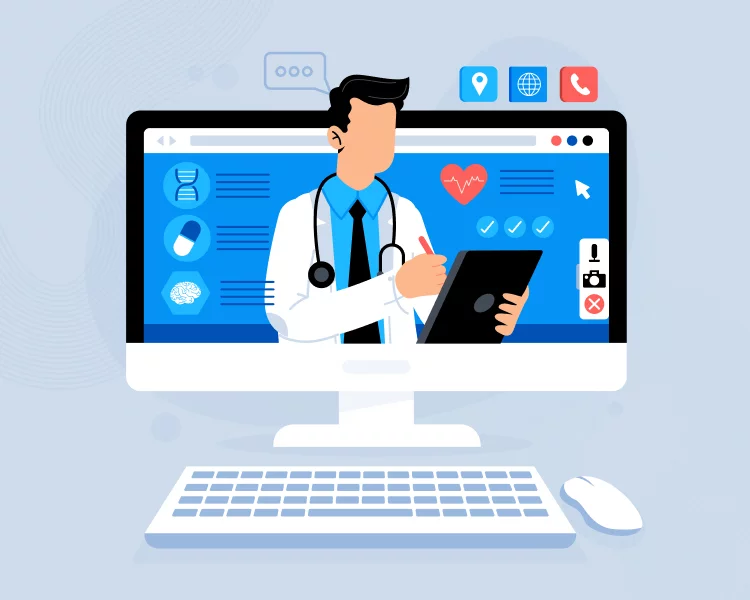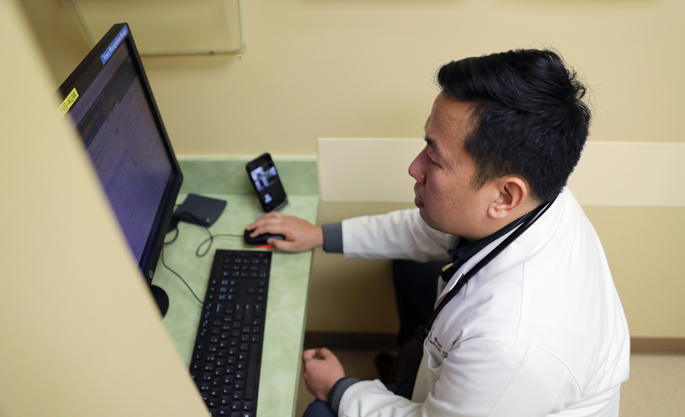Table of Contents
In recent years, telehealth has emerged as a transformative force in healthcare, reshaping the dynamics of patient-provider relationships. This evolution goes beyond the convenience it offers patients; it’s also revolutionizing how medical professionals engage with their patients. In this article, we will delve into the profound impact of telehealth on patient-provider connections and the changing landscape for medical workers in this digital age.
The rapid rise of telehealth represents a paradigm shift in healthcare delivery, bringing with it a host of implications that reverberate throughout the medical landscape. This seismic transformation is not merely about adopting a new technology or platform; it’s about fundamentally redefining the way medical professionals and patients interact and collaborate. Let’s explore this profound impact in greater detail:
1. Empowering Medical Professionals:
Telehealth equips medical professionals with a powerful toolset to enhance their practice. It enables doctors to reach a wider patient base, tapping into previously inaccessible or underserved populations. This expanded reach empowers healthcare providers to make a more significant impact on public health and improve healthcare equity.
2. A Shift in Communication Dynamics:
The traditional healthcare setting often emphasized face-to-face interactions. Telehealth introduces a shift in communication dynamics, emphasizing virtual connections. Medical professionals must adapt their communication skills to effectively convey empathy, compassion and reassurance through screens. This transition has prompted a reevaluation of bedside manners in the digital realm.
3. Patient Engagement and Self-Advocacy:
Telehealth encourages greater patient engagement and self-advocacy. Patients, particularly those managing chronic conditions, have become more proactive in their healthcare journey. They actively participate in virtual consultations, monitor their health data and ask informed questions. This dynamic fosters a collaborative approach between patients and medical professionals.
4. Enhancing Continuity of Care:
Telehealth enhances the continuity of care. Medical workers can seamlessly coordinate patient care across various specialties and settings. This continuity not only ensures comprehensive healthcare but also strengthens patient-provider relationships as patients experience smoother transitions between different phases of their treatment journey.
5. Challenges in Non-Verbal Assessment:
While telehealth offers many advantages, it poses unique challenges for medical professionals. The absence of physical presence makes non-verbal assessment more challenging. Healthcare providers must rely on verbal cues, medical histories and diagnostic data to compensate for the lack of physical examination. This shift necessitates additional training and diagnostic precision.
6. Regulatory and Ethical Considerations:
The surge in telehealth adoption has prompted policymakers to reevaluate regulations and ethics. Medical professionals must navigate a complex regulatory landscape, ensuring compliance with telehealth standards while upholding patient privacy and confidentiality. Ethical considerations, such as informed consent for virtual care, have also come to the forefront.
7. The Future of Hybrid Care:
As we move forward, the concept of hybrid care is gaining prominence. This entails a blend of in-person and telehealth services, allowing medical professionals to choose the most appropriate mode of care for each patient. This flexibility offers a patient-centered approach that optimizes the benefits of both virtual and physical care.
In conclusion, telehealth’s transformative force extends beyond mere convenience; it is reshaping the very essence of healthcare delivery. Medical professionals are navigating this evolution, harnessing the potential of telehealth to enhance patient care, reach broader populations and adapt to the digital age while preserving the essential human elements of compassionate care. As telehealth continues to evolve, medical workers will play a pivotal role in shaping the future of healthcare, ensuring that patient-provider relationships remain at the heart of this digital revolution.
You can also read more about this here: Telemedicine for healthcare: Capabilities, features, barriers, and …
Expanding Access to Care
Telehealth’s most significant contribution to patient-provider relationships is its ability to transcend geographical barriers. Medical workers can now extend their care to patients, no matter where they are located. This expanded reach fosters inclusivity and enables medical professionals to serve patients in underserved or remote areas.
Telehealth, a technological marvel of our times, has brought about a revolution in the realm of patient-provider relationships. Its most profound contribution lies in its ability to transcend the limitations of geography, effectively erasing the boundaries that once constrained healthcare access. In an increasingly interconnected world, this transformation is not only reshaping the way we receive medical care but also catalyzing a paradigm shift in the healthcare industry as a whole.
In the past, the availability of healthcare services was often dictated by proximity to medical facilities. Patients in remote or underserved areas faced significant challenges in accessing timely and quality care. Telehealth, however, has become a powerful equalizer. It empowers medical workers to extend their expertise and compassion across vast distances, reaching patients in the farthest corners of the globe. This democratization of healthcare is a giant leap towards inclusivity, ensuring that medical care is no longer a privilege of the few but a fundamental right for all.
Imagine a specialist in a bustling urban hospital collaborating seamlessly with a patient residing in a rural village, miles away. Through telehealth, this becomes a reality. Medical workers can diagnose, prescribe treatment and provide vital medical advice without the need for patients to endure long and often arduous journeys to distant healthcare centers. This not only saves time and resources but also enhances the overall patient experience, reducing the stress and inconvenience associated with travel.
Telehealth’s impact extends beyond physical distance; it also bridges gaps in healthcare disparities. Underserved communities, often neglected by traditional healthcare models, now have access to a broader spectrum of medical services. This newfound accessibility is especially vital for chronic disease management, preventive care and mental health services, where regular check-ins and timely interventions are paramount.
Moreover, telehealth has shown its resilience in times of crisis, such as the COVID-19 pandemic. It has allowed healthcare providers to maintain essential services while reducing the risk of virus transmission. This adaptability highlights telehealth’s potential as a critical tool for disaster response and preparedness, ensuring that healthcare services remain available even in the face of adversity.
In summary, telehealth’s remarkable ability to break down geographical barriers has transformed patient-provider relationships and healthcare delivery. It has made healthcare more accessible, inclusive and efficient, empowering both medical workers and patients alike. As telehealth continues to evolve and integrate with emerging technologies, its promise in revolutionizing the healthcare landscape is bound to grow, creating a future where distance is no longer a hurdle to receiving the care we all deserve.
Looking for more insights? You’ll find them right here in our extended coverage: Martti by UpHealth | Telehealth in Any Language

Efficiency and Convenience
Telehealth is a game-changer when it comes to efficiency and convenience. Medical professionals can conduct virtual consultations, review test results and follow up on patient progress with ease. This convenience benefits both medical workers and patients, reducing wait times and minimizing the hassle of traveling to a physical clinic.
Telehealth, the integration of technology into healthcare, is nothing short of a revolution in terms of efficiency and convenience. It has completely transformed the way medical professionals interact with patients and has brought a multitude of benefits to both sides of the healthcare equation.
Expanded Access to Healthcare: Telehealth significantly improves access to healthcare, especially for individuals living in remote or underserved areas. Patients no longer need to endure long journeys or extensive travel to reach a healthcare facility. Instead, they can connect with medical professionals from the comfort of their homes, erasing geographical barriers and expanding healthcare access to a broader population.
Efficient Use of Time: Telehealth optimizes the use of time for both medical workers and patients. Healthcare providers can streamline their schedules, efficiently managing a larger number of consultations in a day. This translates to shorter wait times for patients, reducing the often frustrating delays associated with in-person clinic visits.
Improved Follow-Up Care: Telehealth offers an ideal platform for medical professionals to engage in continuous follow-up care. Patients can easily provide updates on their condition and doctors can monitor progress more closely. This proactive approach to healthcare management can lead to better treatment outcomes and a reduced risk of complications.
Enhanced Monitoring and Data Sharing: Remote patient monitoring devices, often integrated with telehealth platforms, allow healthcare providers to gather real-time data on patients’ vital signs and chronic conditions. This data can be instantly transmitted to medical professionals for analysis and timely interventions. This proactive approach to healthcare management can be particularly critical for patients with chronic illnesses.
Reduced Healthcare Costs: Telehealth can lead to cost savings for both patients and healthcare systems. Patients save on travel expenses and healthcare providers can optimize their resources more efficiently, potentially reducing overhead costs associated with maintaining physical facilities.
Patient-Centered Care: Telehealth fosters a patient-centered approach to healthcare. It allows patients to actively engage in their health management, ask questions and receive timely responses. This empowerment enhances the patient-provider relationship and encourages more open communication.
Emergency and Specialty Consultations: In emergency situations or for specialized consultations, telehealth can be a lifesaver. Medical professionals can quickly assess a patient’s condition and provide guidance, which can be critical in cases where time is of the essence. It also facilitates access to specialists who might be located far away from the patient’s location.
Global Reach: Telehealth transcends borders, enabling medical professionals to provide consultations to patients worldwide. This has far-reaching implications, including the ability to share expertise in underserved regions or offer international second opinions for complex medical cases.
In conclusion, telehealth has ushered in a new era of healthcare, one marked by efficiency, convenience and improved access to medical services. It empowers both medical workers and patients to take a more active role in healthcare management while optimizing resource allocation within the healthcare system. As technology continues to advance, the scope and impact of telehealth on healthcare delivery are expected to expand, further enhancing the quality and accessibility of medical services for individuals around the globe.
Looking for more insights? You’ll find them right here in our extended coverage: Leveraging FTTH for Telehealth Revolutionizing Healthcare …

Patient-Centered Care
A patient-centered approach to healthcare is vital and telehealth encourages just that. Patients can now consult with their healthcare providers in the comfort of their own homes, fostering a relaxed environment for open and honest discussions about their health concerns. This dynamic enhances the patient-provider relationship, leading to improved trust and engagement.
A patient-centered approach to healthcare has long been the gold standard and the advent of telehealth technology has breathed new life into this essential paradigm. Telehealth empowers patients with unprecedented convenience and accessibility, making it a cornerstone of modern healthcare delivery.
One of the key advantages of telehealth is the ability for patients to engage with their healthcare providers from the familiar and comfortable surroundings of their homes. This change of setting can have a profound impact on the patient’s mindset. Instead of sitting in a sterile office, patients are encouraged to relax in their own environment, which can foster a sense of ease and openness. This conducive atmosphere lays the foundation for candid and honest discussions about their health concerns.
In this relaxed setting, patients often feel more inclined to ask questions, share their worries and express their needs without reservation. This dynamic not only promotes greater transparency but also encourages active participation in their healthcare journey. Patients become more informed, proactive and engaged, which is instrumental in achieving positive health outcomes.
Moreover, the enhanced patient-provider relationship that telehealth facilitates is built on a foundation of trust and mutual understanding. When patients feel heard and respected, trust in their healthcare providers naturally grows. This trust is further bolstered by the continuity of care that telehealth can offer. Patients can see the same provider consistently, fostering a sense of familiarity and confidence in their care team.
Telehealth also transcends geographical barriers, ensuring that patients have access to specialists and experts they may not have been able to see otherwise. This expanded access to specialized care enriches the patient-provider relationship even more, as patients can receive tailored expertise and guidance for their unique healthcare needs.
In conclusion, the patient-centered approach in healthcare is not just an ideal but a tangible reality through telehealth. By providing a comfortable and accessible platform for healthcare interactions, telehealth nurtures an environment conducive to open and honest discussions. This, in turn, empowers patients to take an active role in their health, fostering trust and engagement that are vital for achieving better health outcomes. The evolution of healthcare through telehealth is a testament to the transformative power of technology in improving patient care and provider relationships.
Should you desire more in-depth information, it’s available for your perusal on this page: Revolutionizing Dialysis Care: Navigating Telehealth, Pediatric Care …

Collaboration with Specialists
Telehealth facilitates seamless collaboration among medical professionals and specialists from around the world. Doctors can easily consult experts in various fields, resulting in more accurate diagnoses and comprehensive treatment plans. Patients benefit from access to a broader network of medical expertise, even in regions with limited local healthcare resources.
Telehealth has ushered in a new era of collaborative healthcare, breaking down geographical barriers and connecting medical professionals and specialists globally. This transformation is not only revolutionizing the way doctors work but also revolutionizing the level of care patients receive.
Global Expertise at Your Fingertips: Telehealth enables doctors to tap into a vast pool of global expertise. They can consult with specialists from different continents, sharing patient information and discussing complex cases in real time. This collaborative approach harnesses the collective wisdom of the medical community, ensuring that patients receive the most up-to-date and comprehensive care possible.
Enhanced Diagnostic Accuracy: The power of telehealth lies in its ability to facilitate multidisciplinary consultations. When facing a challenging diagnosis, a team of specialists with diverse backgrounds can provide invaluable insights. This synergy often leads to more accurate diagnoses and tailored treatment plans. For example, a dermatologist and an immunologist can collaborate on a complex skin condition, combining their knowledge to arrive at a precise diagnosis and treatment strategy.
Timely Interventions: In critical cases where time is of the essence, telehealth can be a lifesaver. A neurologist in one part of the world can assess a stroke patient’s brain scans while a vascular surgeon in another location evaluates the patient’s vascular condition. This simultaneous assessment allows for quicker decision-making and faster interventions, potentially saving lives and reducing the risk of long-term complications.
Access to Specialized Care: In regions with limited local healthcare resources, telehealth bridges the gap between patients and specialized care. People in remote or underserved areas can now access expert consultations without the need for extensive travel. This not only improves patient outcomes but also reduces the strain on overloaded healthcare facilities in urban centers.
Continuity of Care: Telehealth fosters continuity in patient care. A primary care physician can easily confer with a specialist, ensuring that the patient’s treatment plan is coherent and well-coordinated. This seamless flow of information leads to more effective care management and better outcomes for patients dealing with chronic conditions.
Patient Empowerment: Beyond its impact on medical professionals, telehealth empowers patients to take a more active role in their healthcare. Patients gain access to a broader network of medical knowledge and can participate in informed discussions about their treatment options. This collaborative approach fosters trust between patients and providers, resulting in more patient-centric care.
In conclusion, telehealth is not just a technological advancement but a catalyst for a global healthcare revolution. It unites medical experts from around the world, empowers patients with knowledge and elevates the standard of care. As telehealth continues to evolve and become increasingly integrated into healthcare systems, its potential to improve diagnosis, treatment and overall patient outcomes is limitless. It represents a bright future where the best minds in medicine come together to provide top-notch care, regardless of geographical boundaries.
Don’t stop here; you can continue your exploration by following this link for more details: Telemedicine for healthcare: Capabilities, features, barriers, and …

Proactive Healthcare
Telehealth enables medical workers to shift towards proactive healthcare. They can remotely monitor patients with chronic conditions, ensuring timely interventions and reducing the risk of hospitalizations. This approach fosters a more continuous and supportive connection between patients and their providers.
Telehealth is not merely a tool for reactive healthcare; it serves as a dynamic catalyst for the transformation of medical practice into a proactive and patient-centered model. This paradigm shift empowers medical workers to embrace a forward-thinking approach that transcends traditional boundaries, profoundly impacting patient outcomes and the overall healthcare landscape.
Continuous Monitoring for Chronic Conditions: With telehealth, medical workers can establish an unbroken thread of care for patients with chronic conditions. Remote monitoring devices and digital health platforms enable real-time tracking of vital signs, symptoms and adherence to treatment plans. This proactive surveillance allows for the early detection of potential issues, enabling timely interventions that can prevent exacerbations and reduce the need for hospitalizations.
Personalized Care Plans: Telehealth facilitates the creation of highly personalized care plans. Medical workers can analyze patient data remotely, adjusting treatment regimens and lifestyle recommendations based on individual responses and evolving needs. This personalized approach not only enhances the efficacy of care but also strengthens the patient-provider relationship as patients feel valued and understood.
Patient Education and Engagement: Proactive healthcare involves educating patients about their conditions and empowering them to take an active role in their health management. Through telehealth, medical workers can deliver educational resources, facilitate self-monitoring and engage in regular virtual check-ins to discuss progress, answer questions and provide motivation. This collaborative approach fosters a sense of partnership and accountability between patients and their providers.
Reducing Healthcare Costs: By focusing on early intervention and preventative measures, telehealth contributes to the reduction of healthcare costs. Preventing hospitalizations and emergency room visits not only eases the financial burden on patients but also optimizes healthcare resource allocation, making the system more efficient and sustainable.
Data-Driven Decision-Making: Proactive healthcare leverages the power of data analytics. Medical workers can utilize machine learning algorithms and artificial intelligence to predict health trends and identify high-risk patients. This data-driven approach enables providers to allocate resources more effectively and prioritize interventions for those who need them most.
Improved Quality of Life: Perhaps the most significant impact of proactive telehealth is the enhancement of patients’ quality of life. Chronic condition management becomes less burdensome, as patients experience fewer disruptions to their daily routines due to hospital visits. The peace of mind that comes with knowing that their healthcare team is continuously monitoring their well-being can reduce anxiety and improve overall emotional well-being.
Evolving Roles of Medical Workers: The shift to proactive healthcare also necessitates a reevaluation of the roles and skills of medical workers. They become more than caregivers; they become health coaches and data analysts, guiding patients on their wellness journey and interpreting the wealth of health data at their disposal.
In summary, telehealth’s role in fostering proactive healthcare is a testament to the potential of technology to revolutionize the healthcare industry. By facilitating continuous monitoring, personalized care, patient engagement and data-driven decision-making, it propels medical practice into an era where prevention and early intervention take center stage. As this approach continues to evolve, it has the potential to not only improve patient outcomes but also reshape the very essence of healthcare delivery and the roles of medical workers in this transformative journey towards a healthier future.
You can also read more about this here: Seamless Connectivity The Key to Future-proofing Digital Healthcare

Challenges in Non-Verbal Communication
While telehealth offers numerous advantages, it does come with challenges, especially regarding non-verbal communication. Medical professionals may find it more challenging to assess a patient’s body language and physical condition remotely. Addressing this limitation requires the development of new skills and tools for effective virtual communication.
The dawn of telehealth has undoubtedly ushered in a new era of healthcare accessibility, but it is not without its complexities and hurdles. Among the most significant challenges faced by medical professionals in the realm of telehealth is the limitation imposed on non-verbal communication. The absence of physical presence can make it more challenging to assess a patient’s body language, demeanor and overall physical condition, creating a vital need for innovative solutions and skill development in the realm of virtual care.
In traditional face-to-face consultations, healthcare providers have the luxury of observing subtle cues that go beyond words. They can gauge a patient’s anxiety, discomfort or hesitation through their body language, facial expressions and tone of voice. Physical examinations allow for the direct assessment of vital signs and physical symptoms. In telehealth, however, these vital elements of communication are often obscured or altered.
Addressing this limitation requires a multifaceted approach. Medical professionals embracing telehealth must cultivate new skills to compensate for the absence of physical presence. They need to become adept at active listening, honing their ability to discern nuances in a patient’s verbal communication. This involves not only what is said but how it is said, including tone, pauses and hesitations.
Moreover, the development and integration of innovative tools and technologies are crucial. High-definition video conferencing, for instance, can provide clearer visual cues and a more comprehensive view of a patient’s condition. Wearable devices equipped with sensors can transmit real-time data on vital signs and physical activity, bridging the gap in physical assessment.
Telehealth platforms are also evolving to include features that enhance non-verbal communication. Some platforms offer virtual whiteboards and interactive drawing tools that allow healthcare providers to visually explain concepts and treatment plans. These tools can be particularly valuable when discussing complex medical conditions or treatment options.
Additionally, telehealth practitioners are exploring creative ways to replicate physical examination techniques remotely. For instance, they may guide patients in self-examinations or use telehealth-assisted medical devices that can be operated by the patient under the provider’s guidance.
While the challenges of non-verbal communication in telehealth are undeniable, they are not insurmountable. Through a combination of skill development, technology integration and creative adaptation, medical professionals are striving to ensure that the quality of care delivered remotely rivals that of in-person visits. As telehealth continues to evolve, it holds the promise of not only expanding access to care but also enriching the art of remote healthcare communication.
Explore this link for a more extensive examination of the topic: Telehealth challenges during COVID-19 as reported by primary …

Regulatory Considerations
Telehealth introduces complex regulatory considerations for medical workers. Different regions have varying rules regarding telehealth practices, licensure and reimbursement. Medical professionals must navigate these regulatory landscapes to ensure compliance and ethical care.
The regulatory landscape surrounding telehealth is indeed a complex and evolving one, presenting both challenges and opportunities for medical professionals. As telehealth becomes increasingly integral to modern healthcare delivery, navigating these regulations is crucial to ensuring that patients receive ethical and high-quality care across different regions and healthcare systems.
Licensure Challenges: One of the primary regulatory considerations in telehealth is licensure. Medical professionals typically need to be licensed in the state or region where the patient is located, which can be especially cumbersome for virtual care. This requirement can create barriers for healthcare providers who want to offer telehealth services across state or national borders. To address this, some regions have introduced special telehealth licenses or reciprocity agreements to streamline the licensing process for providers practicing remotely.
Interstate Compacts: In the United States, the Interstate Medical Licensure Compact is an example of a regulatory framework aimed at simplifying the licensure process for physicians who wish to practice telehealth across state lines. Participating states allow expedited licensure for qualified physicians, promoting access to telehealth services while maintaining regulatory oversight.
Privacy and Data Security: Telehealth involves the transmission of sensitive patient information over digital channels. Compliance with data privacy regulations, such as the Health Insurance Portability and Accountability Act (HIPAA) in the U.S. or the General Data Protection Regulation (GDPR) in Europe, is paramount. Healthcare providers must ensure that their telehealth platforms and communication tools adhere to these regulations to protect patient confidentiality.
Reimbursement Policies: Reimbursement for telehealth services varies widely from one region to another. Healthcare providers need to understand the reimbursement policies of insurance companies, Medicaid and Medicare in their respective areas. Advocacy efforts are ongoing to expand reimbursement for telehealth services, particularly in light of its increased adoption during the COVID-19 pandemic.
Regulatory Updates: Telehealth regulations are continually evolving. Medical professionals must stay informed about changes in local, regional and national telehealth policies. This requires a commitment to ongoing education and compliance with the latest guidelines to ensure ethical and legal practice.
Medical Standards: Medical professionals providing telehealth services must adhere to the same medical standards of care as they would in an in-person setting. Ethical considerations, such as informed consent, patient autonomy and duty of care, remain paramount, regardless of the mode of care delivery.
Emerging Technologies: As telehealth continues to evolve, new technologies like artificial intelligence (AI) and remote monitoring devices are becoming integrated into healthcare. These technologies introduce additional regulatory considerations, such as data ownership, algorithm transparency and the ethical use of AI in medical decision-making.
Cultural and Ethical Sensitivity: When practicing telehealth across different regions and cultures, healthcare providers must be sensitive to cultural differences and ethical norms. What may be considered acceptable or ethical in one culture may not be so in another. Providers need to adapt their approach to accommodate these variations while upholding ethical standards.
In conclusion, telehealth’s regulatory considerations underscore the need for healthcare professionals to be not only skilled in their medical expertise but also well-versed in the intricacies of healthcare policy and regulation. Effective telehealth practice requires a commitment to ongoing education, collaboration with legal experts and a deep understanding of the unique regulatory landscape in which one operates. By navigating these complexities, medical professionals can provide ethical and compliant telehealth care that expands access to quality healthcare services while respecting regional and national healthcare regulations.
To expand your knowledge on this subject, make sure to read on at this location: Telehealth for the Treatment of Serious Mental Illness and …

Telehealth is redefining patient-provider relationships in healthcare. It offers unprecedented opportunities for accessibility, efficiency and patient-centered care, while also presenting challenges related to non-verbal communication and regulatory compliance. As telehealth continues to evolve and become a standard practice, medical workers must adapt to this changing landscape. Embracing telehealth technologies and developing the skills required for effective virtual care will be essential for medical professionals to thrive in the digital age while maintaining the essential human touch in patient-provider relationships. The future of healthcare is being shaped by telehealth and it holds the promise of more accessible, efficient and patient-centered care for all.
For a comprehensive look at this subject, we invite you to read more on this dedicated page: Telemedicine: Current Impact on the Future – PMC
More links
Don’t stop here; you can continue your exploration by following this link for more details: The Future of Telemedicine: Revolutionizing Healthcare
